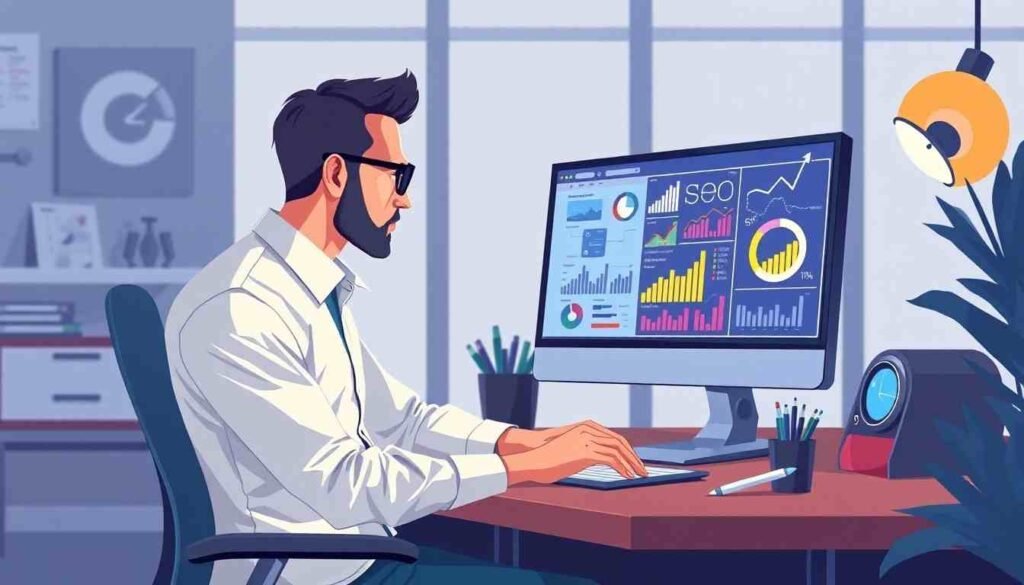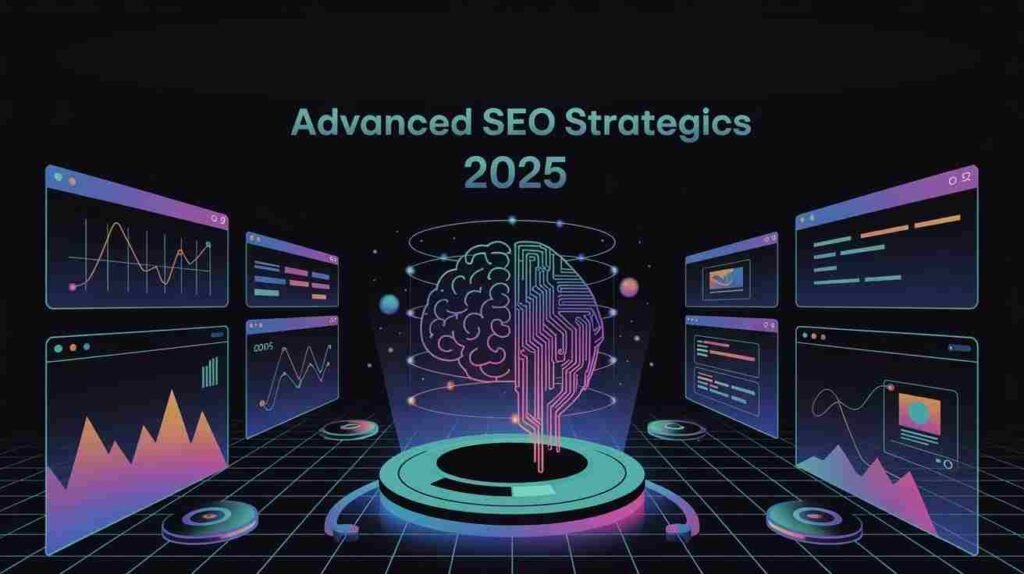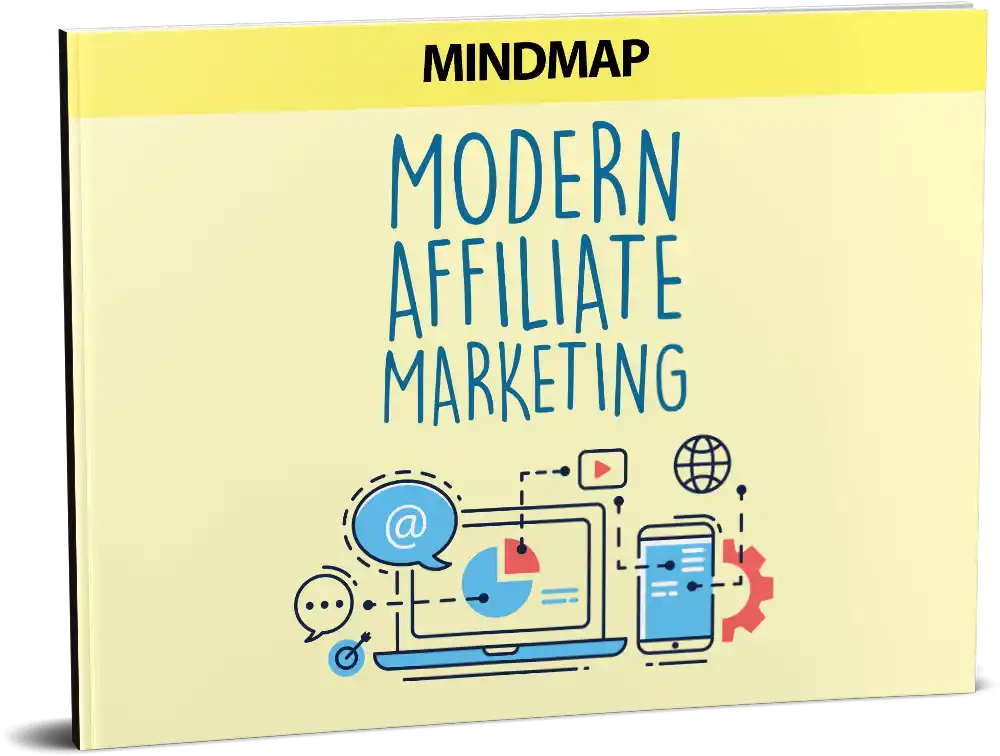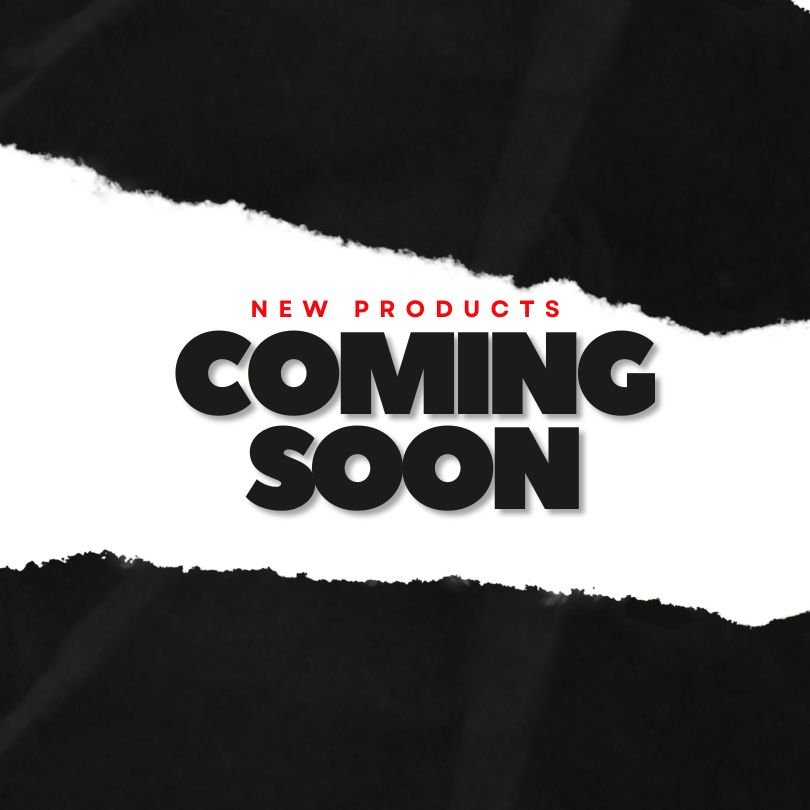
I remember the day I launched my first website back in 2010. After weeks of perfecting the design and content, I proudly showed it to my business partner. His first question? “But how will people find it?” I had no clue. That moment sparked my journey into the complex, frustrating, and ultimately rewarding world of SEO.
Fifteen years and countless algorithm updates later, I’m still learning something new every day. But the fundamentals? Those haven’t changed nearly as much as you might think.
What Is SEO (And Why Should You Care)?
SEO stands for Search Engine Optimization – the art and science of getting your website to show up when people search for stuff related to your business. Simple in concept, maddening in execution.
Why should you care? Well, when was the last time you ventured to page 2 of Google? Exactly. About 95% of all clicks happen on the first page of search results. If you’re not there, you might as well be invisible.
Here’s what blows my mind: Despite how crucial SEO is, many businesses still treat it as an afterthought. My agency regularly takes on clients who’ve spent thousands on beautiful websites that absolutely nobody can find. It’s like building a store in the middle of a desert with no roads leading to it.
The Three Pillars of SEO
Before diving into the tactics, let’s get clear on the big picture. SEO stands on three main pillars:
1. Technical SEO: Making sure search engines can access, crawl, and index your site properly. It’s the foundation everything else sits on.
2. On-page SEO: Optimizing individual pages with relevant, high-quality content and proper keyword usage.
3. Off-page SEO: Building your site’s reputation through backlinks, social signals, and other external factors.
Think of it like a three-legged stool – if any leg is weak or missing, the whole thing topples over. I’ve seen too many businesses hyper-focus on just one aspect while neglecting the others, then wonder why they’re not seeing results.
Technical SEO: The Foundation of Success
When I first started in SEO, you could get away with technical problems if your content was good enough. Not anymore. These days, technical SEO issues can absolutely tank your rankings, no matter how brilliant your content is.
Site Speed: The Need for Speed Is Real
I recently audited a site for a client who couldn’t figure out why their traffic was tanking. Their page load time? A whopping 12 seconds. In a world where users expect pages to load in under 2 seconds, this was digital suicide.
Some quick fixes for improving site speed:
- Compress those massive images (I’m always shocked by how many sites have 5MB header images)
- Enable browser caching
- Minimize redirect chains (I once found a site with 7 redirects before reaching the final URL – yikes!)
- Consider a better hosting solution if needed
Use Google’s PageSpeed Insights to check your current speed. If you’re scoring below 70, you’ve got work to do.
Mobile-Friendliness: No Longer Optional
I still remember arguing with a client in 2015 who insisted mobile optimization wasn’t important for his “professional audience.” Fast forward to today, and over 60% of searches come from mobile devices.
A few weeks ago, I was trying to order takeout from my phone and encountered a site where I had to pinch and zoom just to read the menu. Did I stick around? Nope. Neither will your visitors.
Google’s mobile-first indexing means they primarily use the mobile version of your site for ranking. If your site isn’t mobile-friendly, you’re fighting an uphill battle.
Core Web Vitals: The New Technical Standard
Last year, I watched a client’s rankings plummet overnight when Google rolled out a core update emphasizing page experience metrics. The culprit? Poor Core Web Vitals scores.
These metrics measure real-world user experience in three areas:
- Loading performance (LCP)
- Interactivity (FID)
- Visual stability (CLS)
The Chrome User Experience Report provides data on how real users experience your site. It’s worth paying attention to these metrics before they become a problem.
Structured Data: Helping Search Engines Understand Your Content
I love structured data because it’s one of those technical optimizations that can give you a visible edge. Those recipe cards, star ratings, and event details you see in search results? All powered by structured data.
A local bakery client implemented recipe structured data on their blog posts, and within weeks, their search snippets started showing prep times and ratings. Their click-through rates doubled practically overnight.
Use Google’s Structured Data Testing Tool to check your implementation. It’s like giving Google a cheat sheet for understanding your content.
On-Page SEO: The Art of Creating Content That Ranks
Technical SEO gets you in the game, but content is how you win. On-page SEO is about creating and optimizing content that satisfies both search engines and users.
Keyword Research: The Foundation of Content Strategy
Keywords are the bridge between what people are searching for and the content you provide. Get this wrong, and nothing else matters.
I made this mistake early in my career, creating content based on what I thought people were searching for rather than doing proper research. The result? Crickets.
Some of my favorite keyword research tools:
- SEMrush (pricey but worth it)
- Ahrefs (my personal go-to)
- Ubersuggest (great for beginners on a budget)
- Google’s Keyword Planner (free but limited)
Pro tip: Don’t just chase high-volume keywords. I’ve seen better results targeting lower-volume but highly specific “long-tail” keywords with less competition.
A client in the fitness space was struggling to rank for competitive terms like “weight loss tips.” We pivoted to more specific phrases like “how to lose weight with hypothyroidism” and saw traffic increase by 200% within three months.
Content Quality: The King, Queen, and Entire Royal Court
If there’s one thing I’ve learned in my SEO journey, it’s that there are no shortcuts around quality content. Google’s getting scarily good at determining whether content actually provides value.
What makes content “high-quality” in Google’s eyes?
- Comprehensive coverage of the topic
- Original insights and information
- Clear expertise and authoritativeness
- Good user experience (formatting, readability, etc.)
- Engagement metrics that signal usefulness
Last year, I ran an experiment with two nearly identical pages targeting the same keyword. One was a basic, 800-word overview. The other was an in-depth, 2,500-word guide with original research. The comprehensive page outranked the basic one in just two weeks, despite being newer and having fewer backlinks.
E-A-T: Expertise, Authority, and Trustworthiness
For certain topics (especially those related to health, finance, or major life decisions), Google explicitly looks for signals of E-A-T.
I noticed this firsthand when a medical client’s rankings dropped after a core update. The content was well-written but lacked credentials and citations. After adding author bios highlighting medical expertise and linking to authoritative sources, their rankings recovered within months.
Ways to improve your E-A-T:
- Highlight credentials and expertise of content creators
- Link to reputable sources
- Keep content updated and accurate
- Include about pages, contact information, and policies
- Generate positive reviews and testimonials
On-Page Elements: The Technical Side of Content
While creating amazing content, don’t forget the technical elements that help search engines understand it:
Title Tags: Still one of the most important on-page factors. I aim to keep them under 60 characters and include the primary keyword near the beginning.
Meta Descriptions: While not a direct ranking factor, a compelling meta description improves click-through rates. I try to keep these under 155 characters and include a call-to-action.
Heading Structure: Use headings (H1, H2, H3, etc.) to create a logical hierarchy. I always make sure my H1 contains the primary keyword and subsequent headings include related terms.
Internal Linking: One of the most underutilized SEO tactics. I always include 3-5 relevant internal links in any new content to help distribute page authority and guide users to related information.
Image Optimization: Use descriptive filenames and alt text. I once boosted a travel blog’s image search traffic by 80% just by implementing proper alt text.
Off-Page SEO: Building Your Site’s Reputation
You can control everything on your site, but off-page SEO is about how the rest of the internet perceives you.
Backlinks: Still the Currency of the Web
Despite all the changes in SEO, backlinks remain a critical ranking factor. But not all links are created equal.
I learned this lesson the hard way back in 2013 when a client hired a shady “SEO expert” before coming to me. They had thousands of low-quality links from irrelevant sites, resulting in a manual penalty from Google. It took us 6 months to clean up the mess.
What makes a good backlink:
- Comes from a relevant, authoritative site
- Uses natural anchor text (not always exact-match keywords)
- Appears within contextual content
- Drives referral traffic (a sign it’s actually valuable)
Rather than chasing hundreds of low-quality links, focus on earning fewer, high-quality ones. One link from an industry leader can outweigh dozens from obscure blogs.
Digital PR: The Modern Link Building
The most sustainable way to build links is through digital PR – creating content so valuable that people naturally want to link to it.
My favorite tactics:
- Original research and surveys
- Infographics and visual assets
- Expert interviews and roundups
- Free tools and resources
A financial advisor client created an interactive retirement calculator that generated over 50 high-quality backlinks in the first month alone. The tool cost about $2,000 to develop but would have cost $20,000+ to earn those links through traditional outreach.
Social Signals: The Indirect Influence
While Google claims social shares aren’t a direct ranking factor, I’ve seen too much correlation to believe they don’t matter at all.
Content that performs well on social tends to generate more backlinks, mentions, and engagement – all of which do impact rankings.
A food blogger client saw a recipe go viral on Pinterest, leading to dozens of natural backlinks from other food sites. Within weeks, that recipe was ranking on page one for a competitive keyword.
Don’t treat social as separate from SEO – they’re part of the same ecosystem.
Local SEO: For Businesses Serving Specific Geographic Areas
For local businesses, the SEO game has additional dimensions. I’ve worked with dozens of local service providers whose livelihood depends on showing up in local searches.
Google Business Profile: Your Local SEO Foundation
I still remember helping a struggling local plumber set up his Google Business Profile (formerly Google My Business). Within a month, he was getting 15 new calls per week from Google – enough to completely transform his business.
Optimizing your GBP means:
- Completing every section of your profile
- Adding high-quality photos regularly
- Collecting and responding to reviews
- Posting updates and offers
- Ensuring NAP (Name, Address, Phone) consistency across the web
Local Link Building and Citations
For local businesses, citations (mentions of your business name, address, and phone number) are almost as important as backlinks.
A consistent presence across relevant directories and platforms signals legitimacy to Google. I typically start clients with foundational citations on major platforms like Yelp, Yellow Pages, and BBB, then expand to industry-specific directories.
Local links matter too. A restaurant client gained significant local visibility by sponsoring little league teams and community events – not just for the direct exposure, but for the valuable local backlinks these partnerships generated.
SEO Tools: What’s Actually Worth Paying For

The SEO tool landscape is overwhelming. I’ve probably tried over 100 different tools in my career, and most didn’t justify their cost. Here are the ones that actually provide ROI:
All-in-One Tools
If budget allows, a comprehensive platform like Ahrefs, SEMrush, or Moz Pro can replace multiple point solutions. I’ve settled on Ahrefs after years of testing alternatives. Yes, it’s expensive ($99/month starting), but it saves me hours of work every week.
Free Alternatives
On a tight budget? These free tools can get you started:
- Google Search Console (absolutely essential for any website)
- Google Analytics (the baseline for understanding traffic)
- Ubersuggest (limited but useful keyword data)
- Screaming Frog Free Version (limited to 500 URLs)
- Google’s Mobile-Friendly Test
I started my SEO journey with nothing but these free tools, so don’t let budget constraints stop you.
Measuring SEO Success: Beyond Rankings
Rankings get all the attention, but they’re just one metric among many. I always focus clients on these broader indicators of SEO success:
Organic Traffic Growth
Rankings don’t pay the bills – traffic does. A #1 ranking for a low-volume keyword might be less valuable than a #5 ranking for a high-volume term.
I track organic traffic by landing page, which reveals which content investments are actually paying off. Some of my most successful client pages don’t rank #1 for anything but drive steady traffic from dozens of long-tail variations.
Conversion Metrics
Traffic without conversion is just vanity. For every client, I set up conversion tracking for:
- Primary actions (purchases, leads, etc.)
- Secondary actions (newsletter signups, content downloads)
- Engagement metrics (time on site, pages per visit)
This data tells us which keywords and content actually drive business results, not just traffic.
A SaaS client was thrilled about ranking #1 for a high-volume keyword until we discovered it had a conversion rate of just 0.2%. We pivoted to targeting lower-volume but higher-intent keywords, and conversions tripled despite a slight traffic decrease.
Return on Investment
SEO isn’t free – it costs time, resources, and often direct expenses. Calculating ROI helps justify continued investment.
For ecommerce clients, I track revenue directly attributed to organic search. For lead generation, we assign value to leads based on close rates and average customer value.
One manufacturing client was spending $20,000 monthly on PPC with a 2x ROI. After investing $8,000 monthly in SEO for six months, they were getting a 7x return – more than tripling their marketing efficiency.
The Future of SEO: What’s Coming in 2026 and Beyond
SEO never stands still. Based on emerging trends, here’s what I’m preparing clients for:
AI and Search
AI is already transforming how people search. Voice searches tend to be longer and more conversational. Visual searches bypass traditional keywords entirely.
I’m advising clients to:
- Create content that answers natural language questions
- Implement proper image optimization for visual search
- Structure data in ways that AI can easily interpret
User Experience Signals
Google’s increasing ability to measure real user experiences means traditional SEO tactics won’t compensate for a poor user experience.
Metrics like dwell time, bounce rate, and pages per session are becoming more important. One client improved their rankings simply by redesigning their navigation to encourage deeper site exploration.
Core Web Vitals Evolution
Google continues to refine its page experience metrics. I expect these technical factors to become even more important as Google gets better at measuring them.
My technical team now treats Core Web Vitals optimization as a baseline requirement, not an optional enhancement.
Finding the Perfect Online Job with Live Chat Skills
All this SEO knowledge is valuable – but what if you could put it to work in a flexible, remote position that lets you help businesses succeed online?
With more companies investing in their digital presence, the demand for skilled online workers who understand concepts like SEO has never been higher. Live chat positions are particularly in demand, as businesses recognize the importance of real-time customer engagement.
Live Chat Jobs connects you with opportunities to leverage your digital skills in flexible, well-paying positions. Whether you’re looking to:
- Work from anywhere on your own schedule
- Apply your knowledge of online marketing and communication
- Earn competitive pay without commuting
- Start a new career path with growth potential
- Supplement your income with part-time work
Thousands of people have found their perfect online position through our platform. From beginners to experienced professionals, Live Chat Jobs matches you with opportunities that fit your skills and lifestyle.
Click here to discover your perfect online opportunity and start putting your digital knowledge to work within days, not months.
What kind of remote work schedule would best fit your lifestyle? Share in the comments below, and I’ll personally respond with tailored recommendations!



